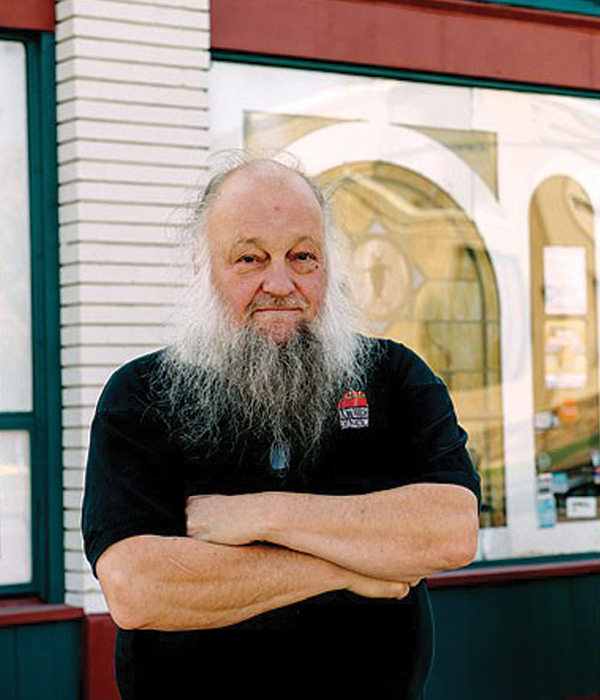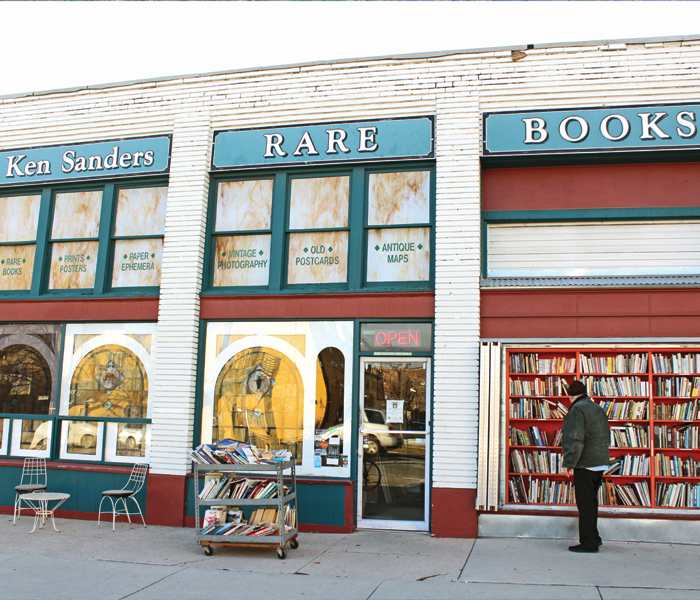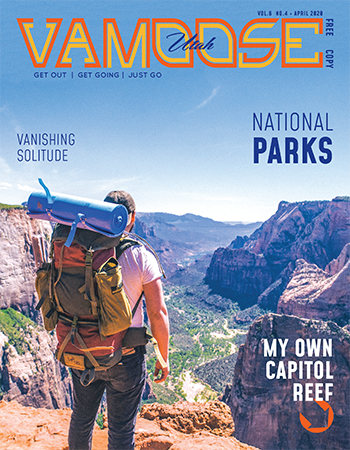Hirsute historian and bookseller Ken Sanders ponders Utah pioneers
By Chris Vanocur
Ken Sanders is a trip. In one quick conversation, he zips from poetry to environmentalism to a Maori version of the Book of Mormon. And then there’s his flowing white beard. It’s long enough that he could easily put on a hat and some shades, and jam with ZZ Top. But more importantly—at least for the purposes of this article—Ken Sanders is someone who can also take you on a trip. One deep into the heart of Utah’s pioneer past.
Sanders is the longtime owner of an independent bookstore in downtown Salt Lake. He estimates he’s got some 100,000 books squirreled away, either at his bookshop or in storage. About a quarter of them, he says, deal with Utah pioneers and Mormons.

Ken Sanders
When I ask what fascinates him about Utah’s pioneer history, Sanders cites his family’s LDS background. While it’s anyone’s guess where Sanders’ spirituality lies these days, his clan does have some Mormon street cred. This includes a wonderfully named great-great-grandfather, Sondra Sanders.
“The history of the Mormon people is just absolutely fascinating,” Sanders (Ken not Sondra) says, “regardless if you’re LDS or not.”
Walking through his (very) cluttered bookstore, visitors can easily find a well-known title such as Fawn McKay Brodie’s No Man Knows My History: The Life of Joseph Smith. But there are also long-forgotten editions of Utah minutiae such as A History of Schools in Iron County, 1851-1970 by Pratt M. Bethers or the Sanpete County Commission’s The Other 49ers: A topical history of Sanpete County, Utah, 1849-1983. To the untrained eye, these books might not seem to have a lot in common. There is, however, a crucial link. As Sanders explains it, “You cannot escape the history of the West without telling the story of the LDS church.”
Given Sanders’ fascination with Utah’s past, it begs the question: Who is his favorite pioneer? While other Utah historians or experts might pick a prominent leader from the 1800s, Sanders’ choice is a bit unexpected. It’s an inventor and innovator from the past century. His name? Thomas Henry Moray.
Now, I’ve been in Utah long enough to speak “Mormon,” but I’m by no means fluent. In other words, I’m familiar with many of Utah’s key pioneers but not those in the footnotes. Thank goodness, though, for Google. A quick search identifies Moray as, “one of the most talented electronic circuit designers in the emerging field of radio.” Who knew?

Well, Ken Sanders knew. Sanders considers Moray to be Utah’s version of Nikola Tesla. (Tesla, for the non-engineers among us, was a groundbreaking pioneer in the field of electrical power). Sanders takes much delight in informing me that Moray conducted his experiments in Emigration Canyon and the Salt Flats. And, for those interested in knowing more about this energy pioneer, Sanders suggests reading his magnus opus, The Sea of Energy in Which the Earth Floats, first published in 1930 and now in its revised 5th edition with a history and biography written by Moray’s son, John E. Moray.
Did I mention talking to Ken Sanders is kind of a trip? Unfortunately, a trip may soon be in store for Sanders and his bookshop. He says future developments on his block could force him to seek out a new location. As he succinctly and darkly puts it, “We’re clearly doomed.”
Sanders adds that finding 5,000 square feet of affordable space either downtown or in Sugar House won’t be easy. But as gloomy as this news may be, Sanders doesn’t seem overly distraught. Perhaps, it’s the sanguine acceptance of a historian, someone who is all too familiar with the changes that time brings.
Meanwhile, back at his beard, my all-too-brief visit with Ken Sanders comes to a close. I am struck, however, by a whimsical notion. Given his prominent, decidedly old-school facial hair, I ask Sanders if people ever tell him he’s looks like a 19th century Utah pioneer? Mischievously, he answers in the positive, “On a good day, it’s Brigham Young. On a bad day, it’s Porter Rockwell.”
This is classic Ken Sanders. In one farewell aside, he references both the revered second president of the LDS church and a shadowy bodyguard to Joseph Smith and Brigham Young, known as the “Avenging Angel.”
But this is what you get with Sanders. His bookstore has a distinct yin-yang vibe. It’s a decidedly secular place, yet one with strong religious ties. It’s a shrine of sorts, a place where much can be gleaned about the rich and varied history of Utah’s forefathers. Visitors may ultimately leave, as I did, marveling at what a long strange trip it’s been.



